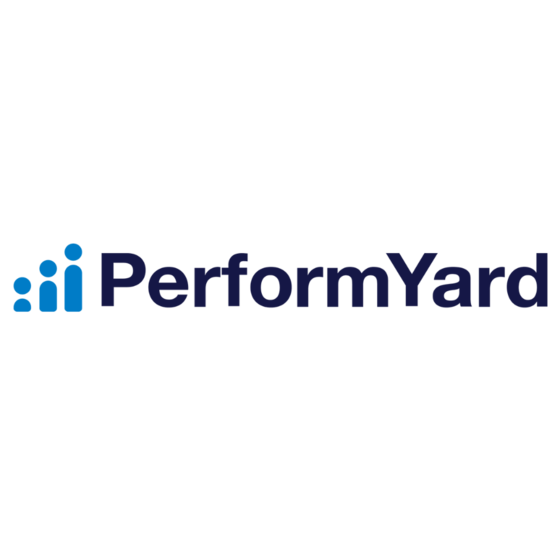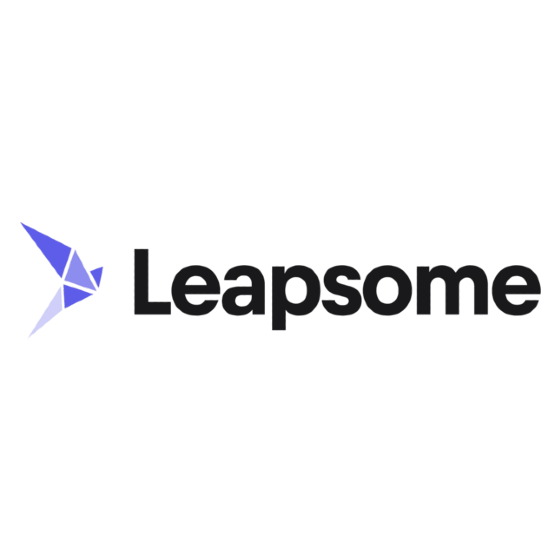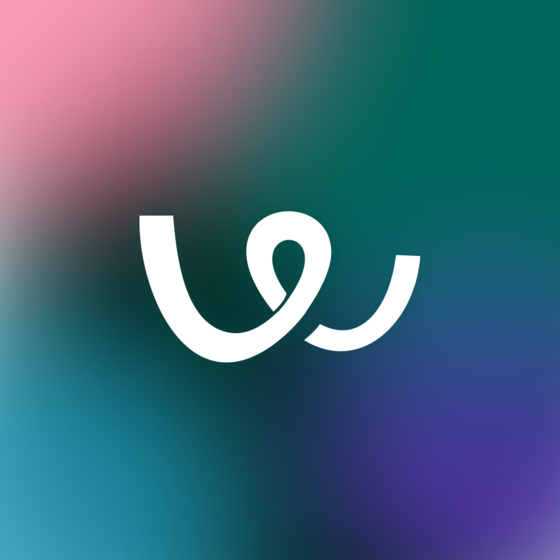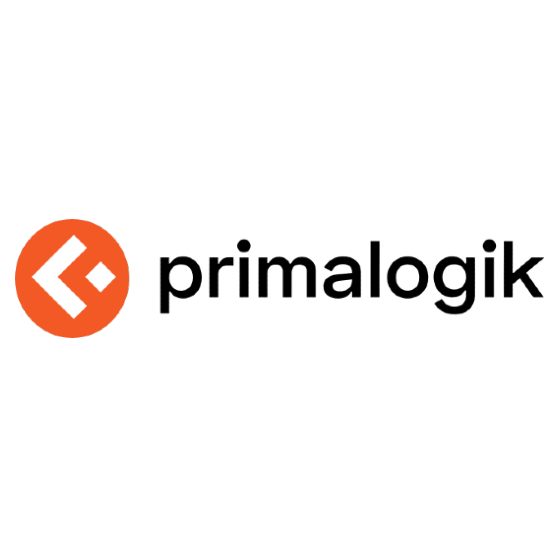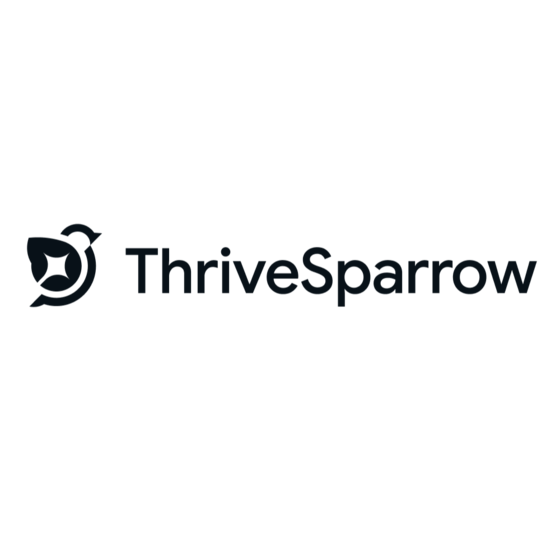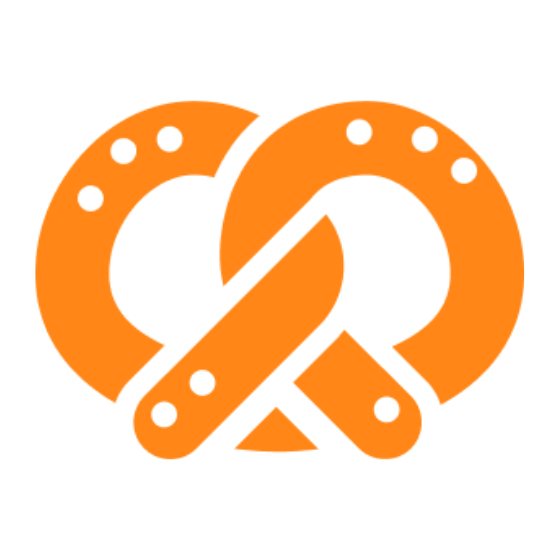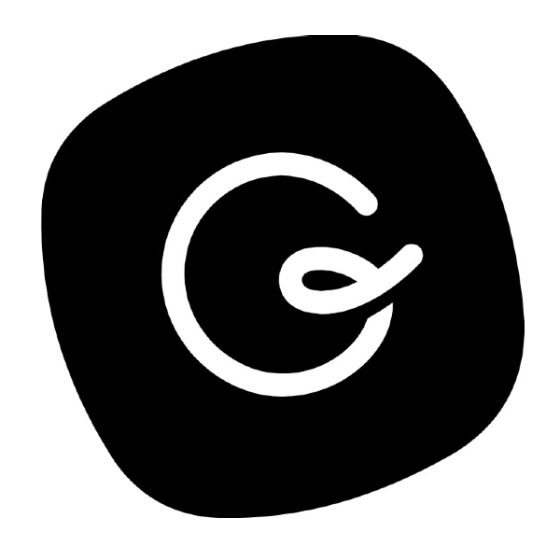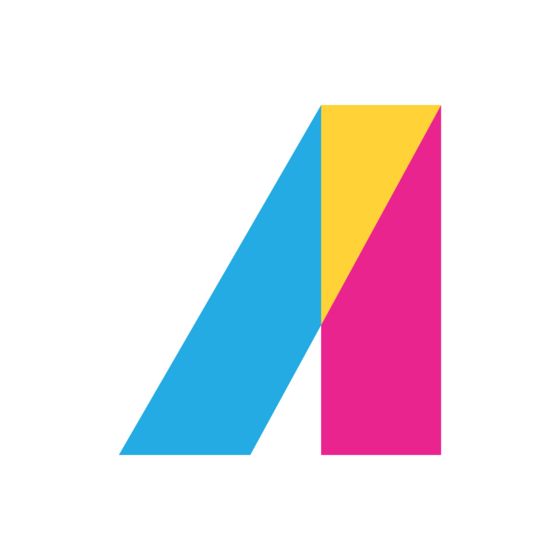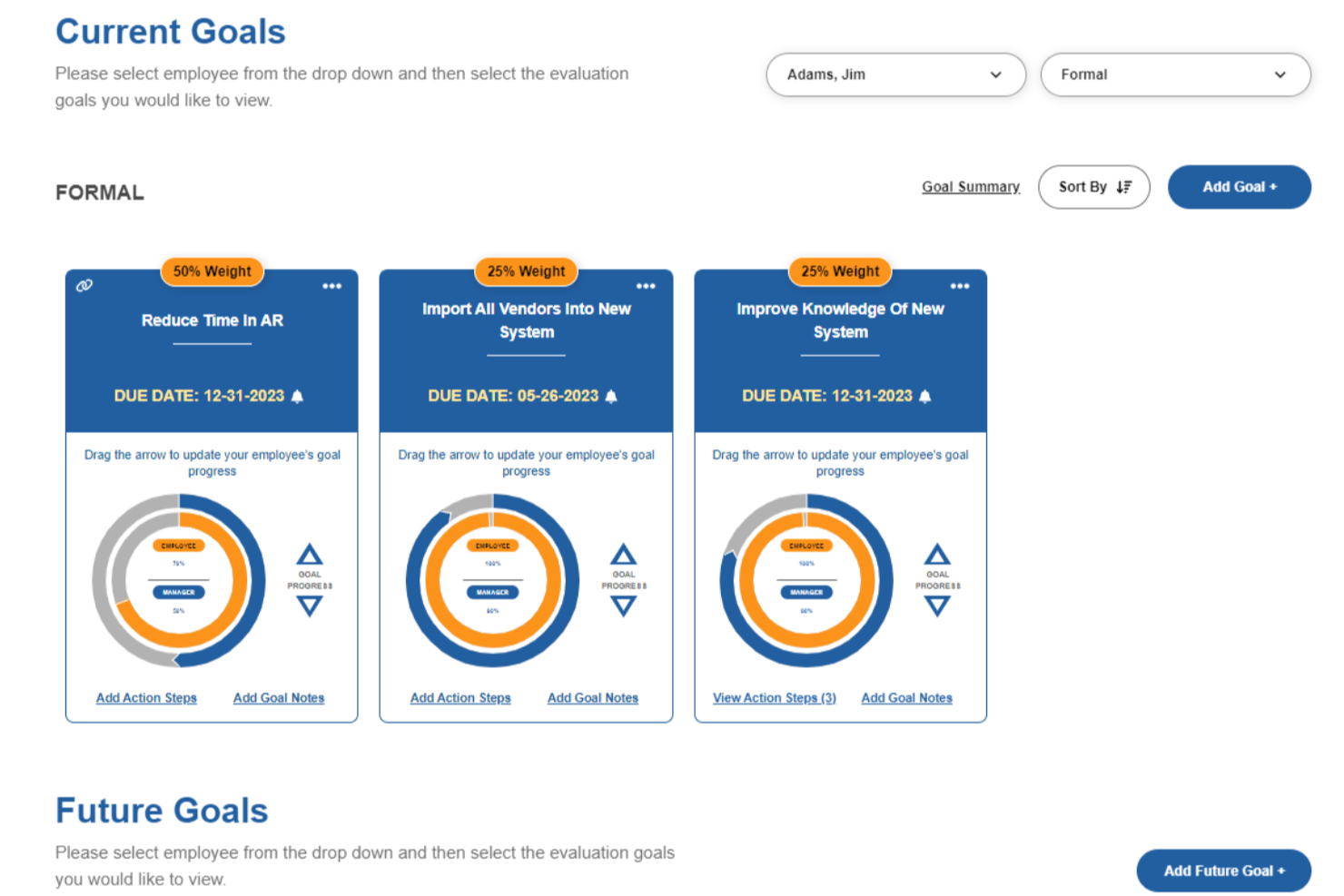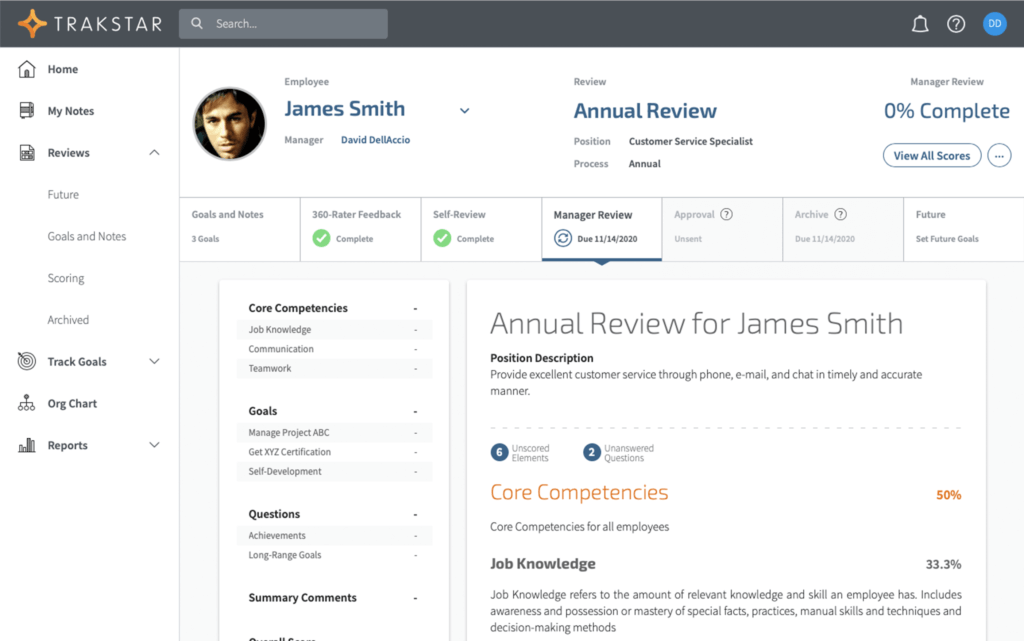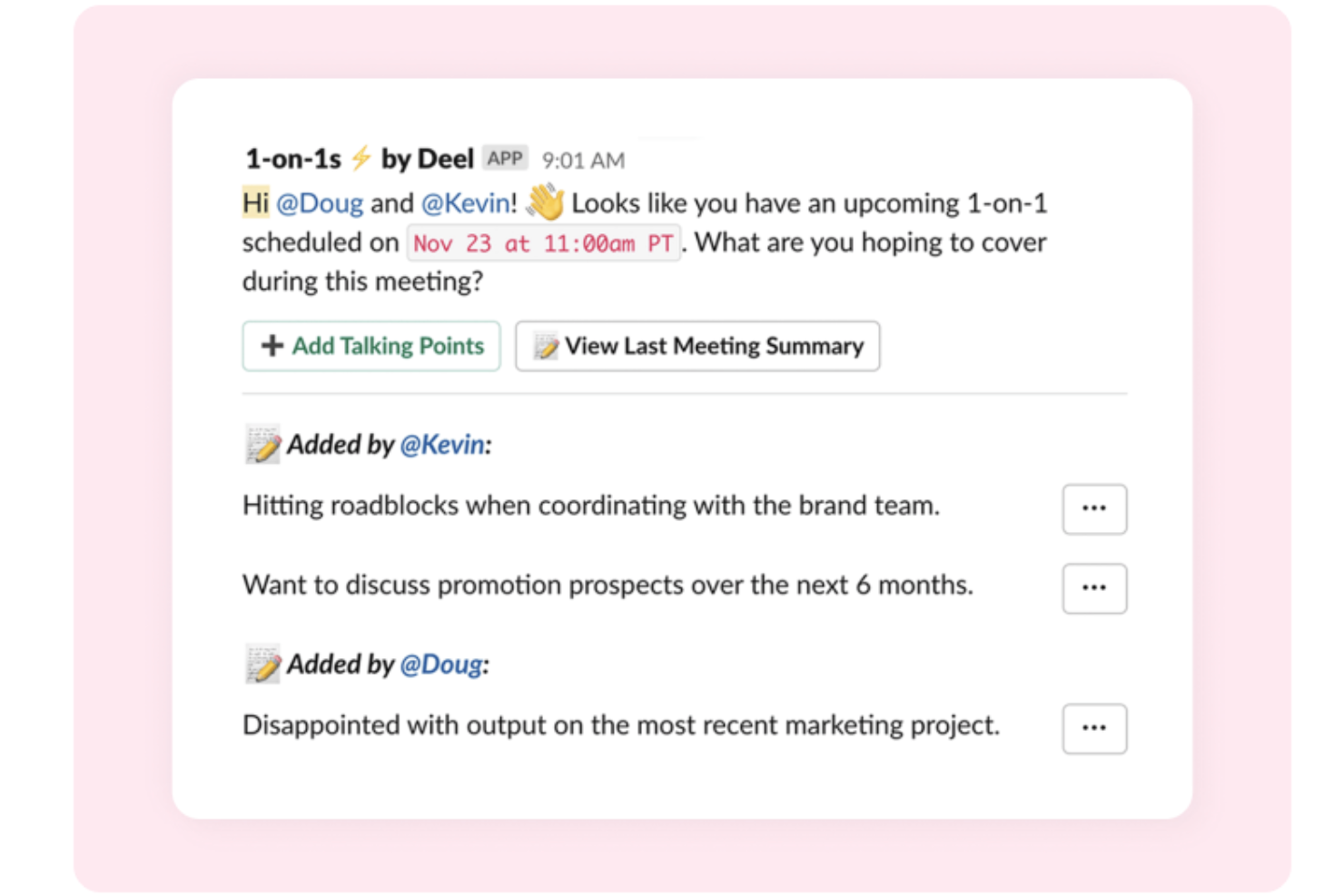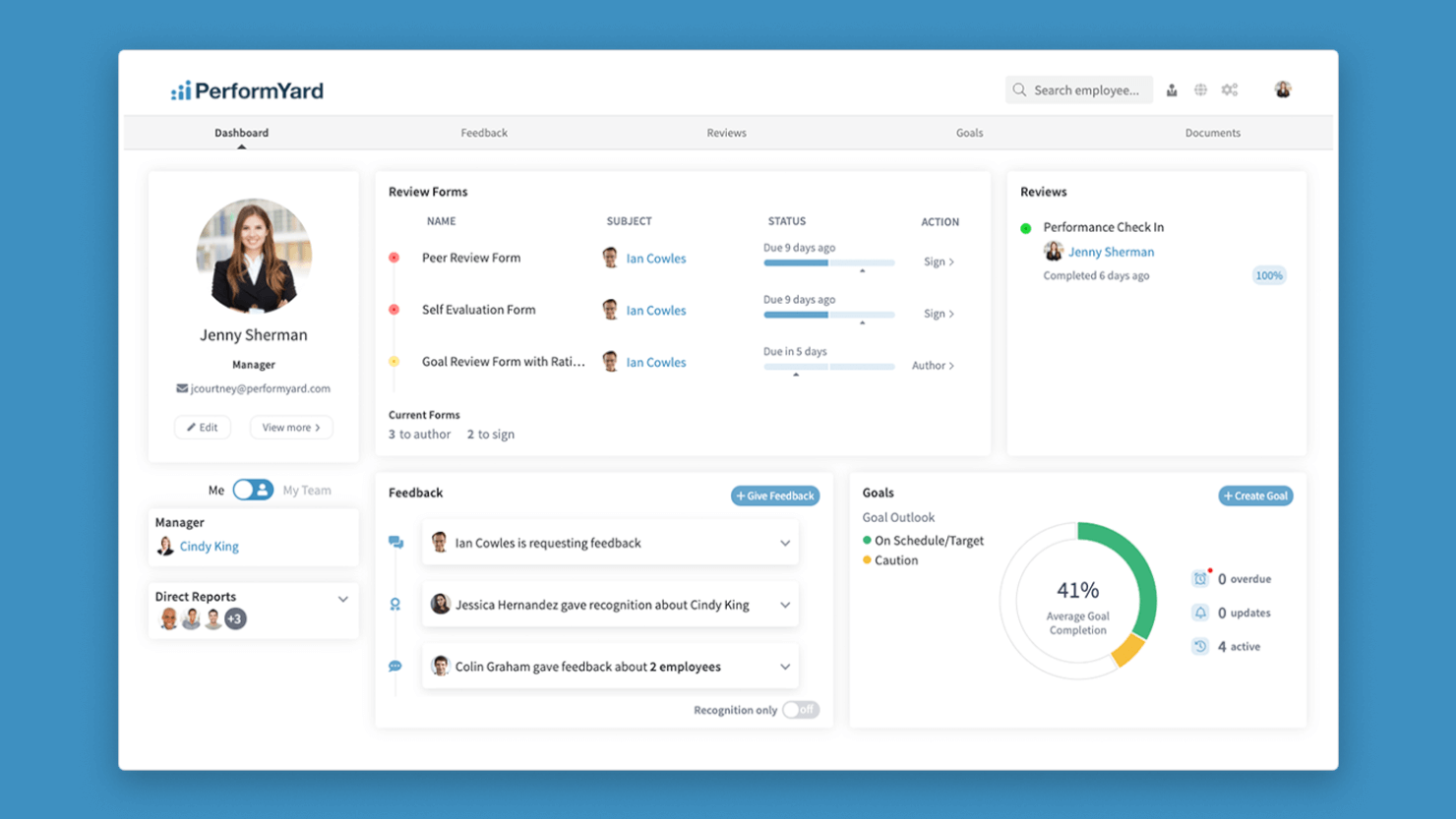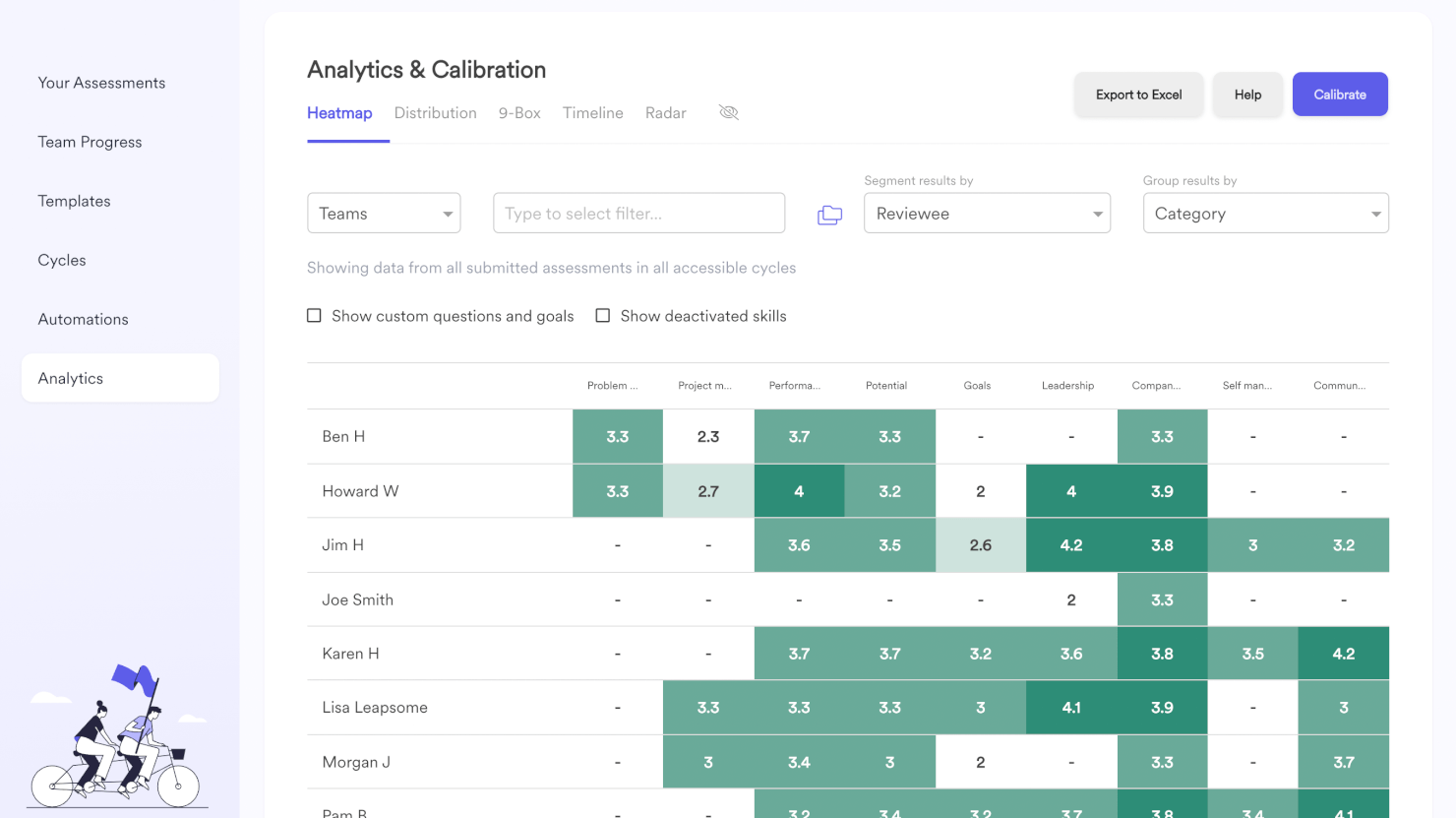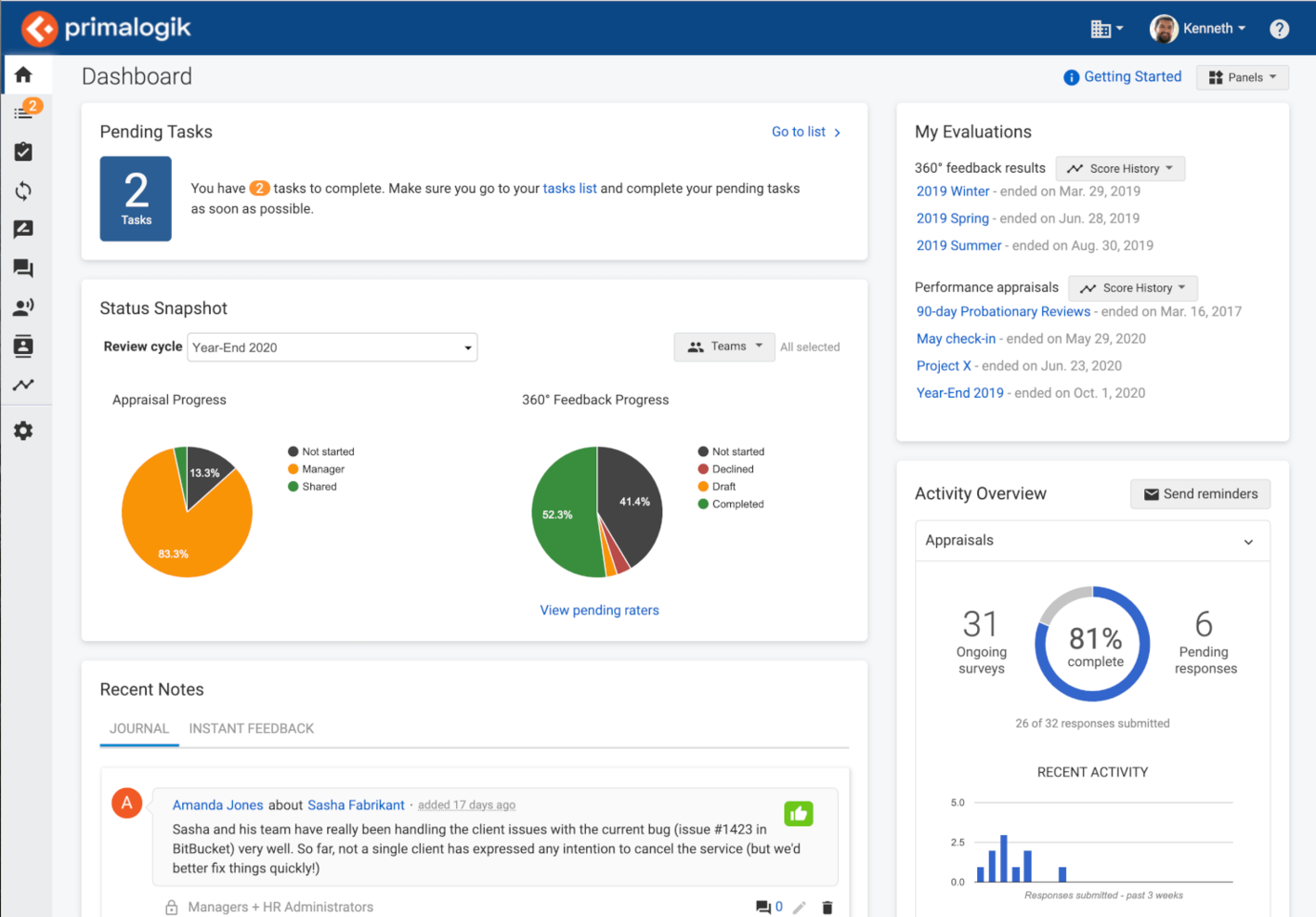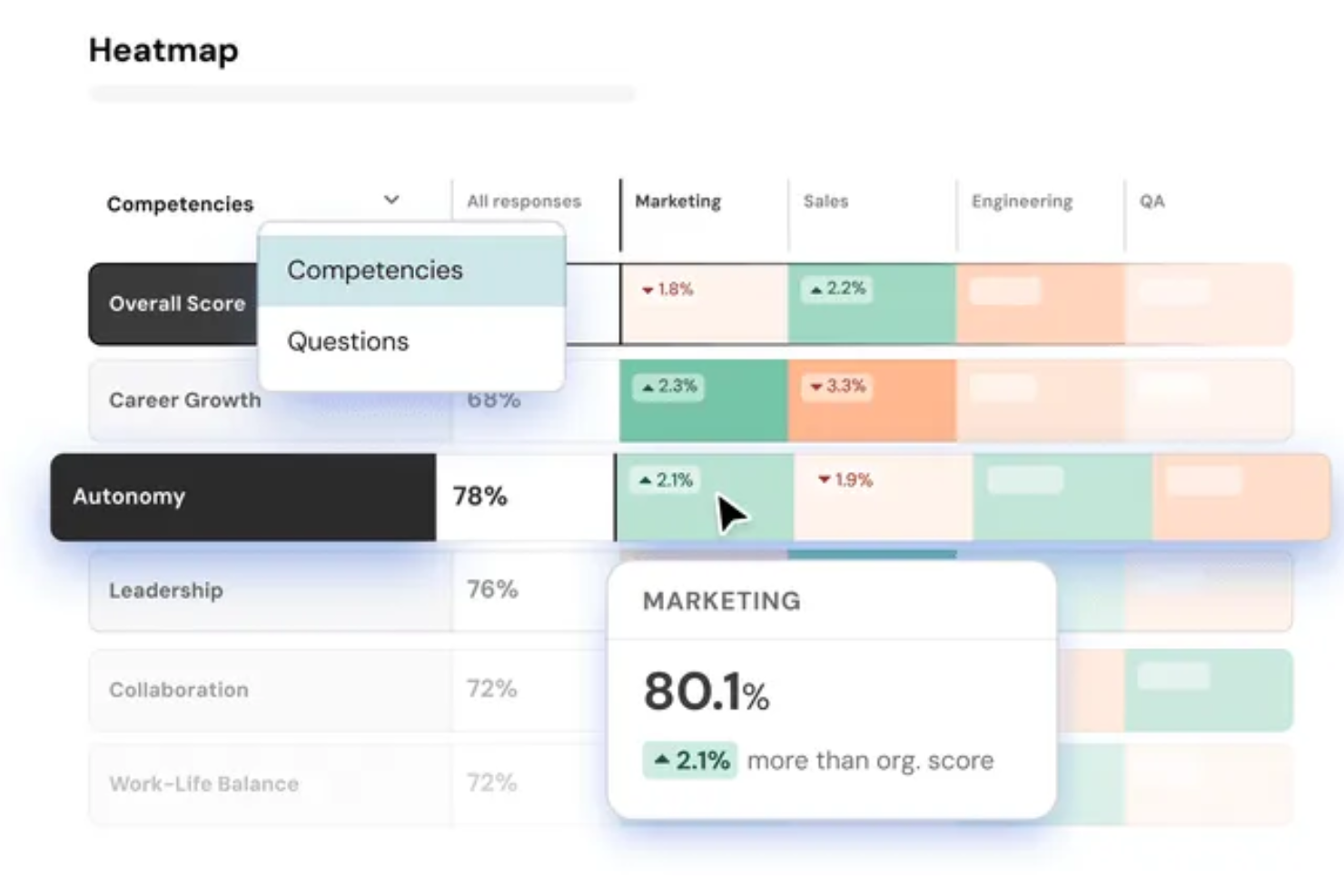10 Best Performance Management Software Shortlist
Here's my pick of the 10 best software from the 30 tools reviewed.
Get free help from our HR software advisors to find your match.
If you're searching for the best performance management software, it's likely because your current process feels disjointed, time-consuming, or just plain ineffective. Maybe you're still chasing down feedback in spreadsheets, struggling to keep reviews consistent, or lacking the data to back your decisions. The right software can change that—helping you automate performance cycles, set aligned goals, gather 360° feedback, and uncover actionable insights that drive employee growth.
Performance management software isn't just a convenience—it’s a critical tool for improving engagement, boosting retention, and creating a fair, transparent workplace. But with so many tools on the market, choosing the right one can be frustrating, especially if you’ve been burned before by clunky or rigid systems.
As a former HR administrator who’s facilitated over 1,000 performance reviews, I know what makes a tool useful—and what gets in the way. In this guide, I’ll walk you through the top-rated performance management software available today to help you find a solution that fits your people, process, and culture.
Why Trust Our Software Reviews
We've been testing and reviewing HR software since 2019. As HR professionals ourselves, we know how critical and difficult it is to make the right decision when selecting software.
We invest in deep research to help our audience make better software purchasing decisions. We've tested more than 2,000 tools for different HR use cases and written over 1,000 comprehensive software reviews.
Learn how we stay transparent, and take a look at our software review methodology.
Best Performance Management Software: Comparison Chart
This comparison chart summarizes pricing, trial, and demo details for my top performance management software selections to help you find the best software for your budget and business needs.
| Tool | Best For | Trial Info | Price | ||
|---|---|---|---|---|---|
| 1 | Best for evaluating individual competencies | Free demo available | From $2 to $7/employee/month | Website | |
| 2 | Best for employee lifecycle performance | Free demo available | Pricing upon request | Website | |
| 3 | Best for continuous 1:1 performance feedback | Free trial + demo available | From $29/month | Website | |
| 4 | Best for customized performance review processes | Free demo available | From $5 to $10/user/month | Website | |
| 5 | Best for development-focused performance | 14-day free trial | From $8/user/month | Website | |
| 6 | Best for multi-level performance feedback | Free trial available | From $299/month | Website | |
| 7 | Best for scalable review processes | 30-day free trial | From $3 to $8/user/month | Website | |
| 8 | Best for actionable development insights | Free forever plan (up to 1 user) | Pricing upon request | Website | |
| 9 | Best for AI-powered performance insights | 14-day free trial | From $2/employee/month | Website | |
| 10 | Best for multiple performance management processes | Free demo available | From $7/user/month, resume screening pricing upon request | Website |
-

Rippling
Visit WebsiteThis is an aggregated rating for this tool including ratings from Crozdesk users and ratings from other sites.4.8 -

Guru
Visit WebsiteThis is an aggregated rating for this tool including ratings from Crozdesk users and ratings from other sites.4.6 -

Absorb LMS
Visit WebsiteThis is an aggregated rating for this tool including ratings from Crozdesk users and ratings from other sites.4.6
Best Performance Management Software Reviews
Finding the right performance management tool can transform the way you track, evaluate, and support your team’s growth. In this section, I’ve carefully reviewed the top 10 tools that stood out from the rest.
Below, you’ll find an in-depth breakdown of their standout features, strengths, and potential drawbacks, along with insights on why each tool made the cut. Plus, I’ll highlight key integrations and ideal use cases to help you pinpoint the best fit for your organization. Now, let’s dive in!
Performance Pro is a performance management tool designed for HR teams to assess and develop employee skills and competencies. It focuses on streamlining evaluations, goal setting, and feedback processes to improve individual and team performance.
Why I picked Performance Pro: The software offers tools specifically tailored to competency-based evaluations. With features like customizable performance templates and automated review cycles, it simplifies assessing individual skill sets.
You can track progress against set goals, ensuring employees align with organizational objectives. It also includes development planning tools to support growth and learning opportunities. These features make it a practical choice for teams seeking a structured approach to performance management.
Performance Pro Standout Features and Integrations:
Features include templates for employee evaluations, goal-setting tools for teams and individuals, and built-in analytics to track performance metrics. You can also access automated reminders for evaluations, reducing administrative work. Development tracking options allow you to monitor progress and adjust plans as needed.
Integrations include ADP, Paycor, Paychex, BambooHR, and Compease.
Mitratech Trakstar is a streamlined performance management tool without all the fluff. It offers organizations performance appraisal and employee engagement software within an interface that’s easy on the eyes and looks quite like some of today’s social networking sites.
Why I picked Mitratech Trakstar: Their HR platform offers a comprehensive set of features which are offered via 4 core modules:
- Perform, covering performance management, goals, and employee development,
- Learn, covering for onboarding, training, and skill development,
- Hire, covering for hiring and applicant tracking, and
- Insights (for monitoring data and calculating workforce analytics.
All their modules are interconnected, which helps HR teams modernize multiple core employee lifecycle areas with one software investment.
Mitratech Trakstar Standout Features and Integrations:
Features include performance reviews with automated reminders, employee engagement surveys, 360-degree/multi-rater feedback, performance benchmarks, employee self-appraisals, and goals across hundreds or thousands of employees. You can also build customized appraisal forms, set SMART goals, and create flexible workflow processes to meet the needs of your organization.
They can accommodate SMBs and enterprises with their volume-discount pricing plan, though you'll need to request an individualized quote via their website.
Integrations include Microsoft Office 365, Google Workspace, ADP Workforce Now, BambooHR, Paylocity, Namely, UKG Pro, Okta, Azure, OneLogin, Docusign, Slack, and many others.
Deel is a comprehensive HR platform that offers payroll, onboarding and offboarding, workflow and document management, and other helpful tools.
Why I picked Deel: Using Deel, you can ensure employees and contractors are set up for high performance from day one with the system's onboarding workflows.
To manage performance on an ongoing basis, you can use the integrated 1-on-1 meeting tool in the platform. Managers and employees can document meeting notes, and refer back to what they discussed during formal performance evaluations.
Deel Standout Features and Integrations:
Features include a Slack integration that tracks all your 1-on-1s right in Slack, keeping key information centralized for easy access and reference. In addition to 1-on-1 conversations, you can monitor employee engagement levels using the pulse surveys and facilitate important team- and company-wide communications through the software.
In addition to Deel's performance features, their global HR platform is also able to support global businesses with hiring and managing employees and contractors in over 150 countries. To do this, Deel acts as an employer of record (EOR) so you can hire internationally without setting up a local entity.
Integrations include Ashby, BambooHR, Expensify, Greenhouse, Hibob, Netsuite, Okta, OneLogin, Quickbooks, SCIM, Slack, Xero, Workday, and Workable. They also have an Open API that supports additional custom integrations as well.
PerformYard's performance management software provides flexible features for HR and a simple employee experience. HR teams will get the tools they need to build out any performance management strategy while employees get a streamlined experience so they can focus on quality feedback and effective performance discussions.
Why I picked PerformYard: With PerformYard you can build and manage performance cycles that fit the way your team works, whether you're running annual reviews, project-based check-ins, or something else entirely. You can set up different workflows for different teams, automate parts of the process, and collect feedback in multiple formats.
If your company has a unique way of doing reviews, this flexibility might suit you. For example, you can customize their software to fit the strategy that's right for your organization: 360s, project based reviews, ratings scales, continuous feedback, and/or cascading goals.
It supports both structured and informal feedback, so you're not locked into a single approach. Goals and feedback can also be customized per department or team.
PerformYard Standout Features and Integrations:
Features include performance journals for ongoing feedback, visual org charts to understand team structures, and a goals dashboard to keep everything aligned. You can manage review cycles across multiple groups at once. There's also a built-in feedback request tool that lets employees ask for input anytime. Essentially, it provides a simple employee experience that facilitates feedback and quality conversations.
PerformYard also provides dedicated customer success managers for every customer to manage them from onboarding, to employee trainings, to ongoing support.
Integrations include ADP, BambooHR, Gusto, HiBob, Justworks, Rippling, UKG Pro, Paycom, Workday, and Paylocity.
Leapsome is an all-in-one performance management and employee engagement tool that helps organizations enhance their management processes. Chosen by companies like Spotify, Northvolt, and Babbel, Leapsome enables a continuous cycle of performance management and personalized learning that powers the growth of your people and business.
Why I picked Leapsome: I appreciate how their OKRs & goals module helps you manage objectives at the company, team, or individual level. Thanks to its ease of use and intuitive visuals, the tool helps you connect the big picture to the tiny details using flexible metrics, easy visualization of dependencies and goal progress, and goal trees.
Leapsome Standout Features and Integrations:
Features include anonymous/non-anonymous feedback, expert templates, skill frameworks, development paths, automations, and powerful analytics. Their 360-reviews are fully customizable and easy to set up and include customizable questions, frequency, participants; segmentation by department, performance; and automated analytics.
Their employee engagement surveys can identify engagement drivers and measure your employees‘ satisfaction over time. Whether through custom questions or Leapsome's expert templates, the tool helps you turn company sentiment into action.
Their performance platform also offers meeting management to conduct effective 1-on-1s or team meetings with any employee in your organization, driven by a well-structured agenda and talking points.
Integrations include Personio, BambooHR, HiBob, Workday, Rippling, PayFit, ADP, Active Directory, SFTP Integrations, Slack, Jira, Microsoft Teams, calendar apps, and Single Sign-On (SSO).
Workable HR is an all-in-one HR software platform that focuses on improving hiring, onboarding, and employee management, through AI-driven automation.
Why I picked Workable HR: When it comes to performance management, Workable offers a range of features to keep track of progress, including customizable performance review forms and review cycles. This allows you to tailor performance reviews to align with your company goals and employee development, ensuring that you can evaluate your team's progress in a way that makes sense for your business.
Workable HR Standout Features and Integrations:
Features include performance review templates that are configurable for different roles and departments, customizable review cycles, and detailed performance analytics. Once you've customized the templates to fit your specific needs you can save them and re-use them for each review cycle.
Additionally, the multi-level feedback system facilitates comprehensive evaluations by incorporating self-reviews, manager reviews, and 360-degree feedback from peers.
Integrations include Indeed, BambooHR, HiBob, Checkr, Certn, ADP, Deel, LinkedIn, G-Suite, Microsoft 365, Spark Hire, and Slack.
Primalogik’s scalable employee performance management software includes a wide range of features that foster employee engagement and empower managers and their employees to reach their full potential.
Why I picked Primalogik: Their 360-degree feedback module makes it easy to solicit feedback from multiple sources. Admin users can select their own rating scales for their evaluation questionnaires, and determine the level of anonymity that will be applied to the feedback.
Once employee feedback is in the system, Primalogik has several tools to support deep analysis of the data. For example, their system allows managers to compare employees’ self-ratings side-by-side against other respondent's feedback. This helps identify any blind spots between where an employee believes they are, and what their co-workers have suggested.
As well, their Comparison Mode allows admin users to benchmark each employee appraisal and compare them across their workforce — a useful way of identifying their overall top performers or spotting potential company-wide skill gaps.
Primalogik Standout Features and Integrations:
Features include performance review assessments, 360-degree feedback, engagement surveys, employee goals and OKRs (objectives and key results), and instant feedback including 1:1 check-ins. Collectively, these features help Primalogik users gain insight into employees' individual performance and uncover areas to make small improvements.
Advanced features in this module include the option for managers and admin staff to launch feedback requests about their employees and solicit responses from specific co-workers, automatic reminders to provide feedback by a certain date, and real-time feedback tracking.
Integrations include ADP, BambooHR, Google Workspace, Microsoft Azure, and Okta. Their performance management software is also available in Spanish or French.
Spidergap is a performance management tool built around its 360-degree feedback software, which supports employee development by helping individuals identify and act on growth areas. It’s used by teams of all sizes to run feedback cycles that lead to meaningful conversations rather than dense data dumps.
Why I picked Spidergap: I picked Spidergap because it prioritizes clarity in its reports—something that often gets lost in traditional performance review tools. Each feedback report is structured to surface actionable development insights instead of overloading recipients with graphs or vague scores. The templates are flexible, too, which means you can adjust the questions and workflow based on your team’s structure or role levels. For organizations that want to measure the impact of their efforts, the built-in ROI survey can help track whether feedback is actually moving the needle.
Spidergap Standout Features and Integrations:
Features include guided setup tools that walk you through your first project, automatic email reminders to keep participants on track, and admin dashboards for monitoring feedback progress across teams. You can also preview the participant experience before launch to catch any issues early and ensure the process runs smoothly.
Integrations include Google, Excel, and Intercom.
ThriveSparrow is an AI-powered employee success platform that focuses on improving workplace performance and engagement. It provides performance review tools, engagement insights, and goal alignment to foster high-performing teams and a positive work culture.
Why I picked ThriveSparrow: The platform offers 360-degree performance reviews, which gather comprehensive feedback from peers, managers, and the employees themselves, ensuring a well-rounded assessment of performance. This is further supported by tools for employee recognition, engagement surveys, and goal-setting using objectives and key results (OKRs).
The integration of AI insights and multilingual surveys also allows ThriveSparrow to efficiently analyze performance data, equipping organizations with the necessary tools to monitor and improve employee outcomes.
ThriveSparrow Standout Features and Integrations:
Features include full-cycle 360 degree reviews, individual performance reports for employees and team-based performance analytics for leaders, performance heatmaps, competency scoring, detailed performance analytics, and trend visualization tools to uncover strengths and potential skill gaps.
Managers can also view the performance information for their entire team in one place, making it easier to uncover future leaders within large teams.
Integrations are available with 60+ popular systems, including Slack, Microsoft Teams, Google Workspace, Bob, UKG, Gusto, Workday, BambooHR, Dayforce, ChartHop, Justworks, Employment Hero, Kallidus, JumpCloud, and many others.
Peoplebox.ai is an AI-powered performance management software that consolidates multiple performance-related processes into a single platform. It offers tools for performance reviews, 360-degree feedback, career pathing, 1:1 meetings, surveys, and reporting.
Why I picked Peoplebox.ai: One reason I like Peoplebox.ai is its customizable review setup. You can create your own questions, customize forms, and assign specific weightage to goals, competencies, and values. This flexibility lets you tailor the performance review process to fit your team's unique needs.
Another notable feature is the ability to conduct performance reviews, OKRs, and 1:1 meetings directly within Slack or Microsoft Teams. This integration means your team can manage performance tasks without switching between multiple tools, making the process more efficient.
Peoplebox.ai Standout Features and Integrations:
Features include customizable templates, goal alignment, performance tracking, 360-degree feedback, career pathing tools, survey capabilities, reporting dashboards, real-time analytics, competency mapping, automated reminders, performance rating calibration, and people analytics.
Integrations are available with a number of tools, including Asana, BambooHR, Google Sheets, Google Workspace, Microsoft Office, Microsoft Teams, Zoho People, and Slack.
Unlike other tools, its integration with Slack/Teams goes beyond notifications and lets you do entire performance reviews, engagement surveys, and OKR check-ins right within Slack/Teams.
Other Performance Management Software
Still haven’t found the right performance management tool for your team? Here are some more worthwhile performance management software options that didn’t make it into the top 10 list but still deserve a special mention. Check them out!
- GoCo
Automated performance reviews and feedback
- Profit.co
For real-time performance tracking
- IntelliHR
With people analytics
- Kallidus Learn
User-friendly continuous performance reviews
- Mirro
For peer-to-peer recognition
- eloomi
For personalized employee development
- Kallidus Perform
For enterprise performance management
- Factorial
For real-time performance insights
- Synergita
For performance management tied to OKRs
- PeopleFluent
For scalability
- WorkDove
For performance reviews and goal setting
- bob
For continuous feedback and deep HR analytics
- Insperity
For performance templates
- Betterworks
For performance conversation cycles
- Ascender HCM
For personally-tailored development plans
- Teamflect
Integration with Microsoft Teams
- Kazoo
For employee growth plans
- ClickUp
For goals and weekly scorecards
- Lattice
For incorporating multiple feedback sources
- ClearCompany
For goal tracking with reviews
Related HR Software Reviews
If you still haven't found what you're looking for here, check out these other related tools that we've tested and evaluated:
- HR Software
- Payroll Software
- Recruiting Software
- Employer of Record Services
- Applicant Tracking Systems
- Workforce Management Software
Selection Criteria for Performance Management Software
Selecting the right performance management software requires a deep understanding of the performance review process and how advanced software can alleviate common pain points.
Drawing on my personal experience preparing over 1,000 performance reviews, I developed a comprehensive approach to evaluating these tools. My experience also made it easier to pinpoint the features that add a lot of value and ensure a smooth and unbiased evaluation process — features I wish I'd had in the past!
Here's a summary of the main features I evaluated to create this list:
Core Performance Management Functionalities (25% of total score): To be considered for inclusion in my list of the best performance management software, the solution had to fulfill the following basic functionalities:
- Performance data management tools, either as a standalone product, or as a module within an HCM, HRIS, or HRMS application
- Comprehensive performance reviews and professional development plans that align with individual and company growth goals
- Goal setting and tracking tools to help users set clear, measurable objectives and monitor goal progress over time.
- Automation tools to streamline the scheduling, execution, and documentation of performance reviews.
- Real-time feedback mechanisms to gather and share continuous feedback between managers and employees.
- Reporting and analytics tools to save managers and HR professionals from the hassles of manual data calculations - my biggest pet peeve of all!
Additional Standout Features (25% of total score): To help me find the best software out of numerous available options, I also kept a keen eye out for unique features, including the following:
- 360-degree feedback tools to collect feedback from numerous sources to obtain a comprehensive view of an employee's performance
- Innovative goal-setting frameworks that incorporate OKRs or SMART goals.
- Advanced analytics with predictive capabilities for identifying talent risks and opportunities.
- Sophisticated data analysis and presentation tools, including data visualization options, trend identification tools, and flags for achievements or areas for improvement.
- Integrated employee development planning tools that link directly to performance outcomes.
- Customizable review cycles and feedback templates that adapt to various team and department needs.
- Mobile app availability, ensuring access and engagement with the platform anywhere, anytime.
- Helpful resources like performance improvement plan (PIP) templates and personalized career development plans.
Usability (10% of total score): To evaluate the usability of each system, I considered the following:
- An intuitive user interface that simplifies navigation and task completion.
- Automated workflows to ensure no performance reviews slip through the cracks.
- Role-based access controls that are straightforward to configure, accommodating different user needs within the organization.
- Interactive dashboards that present data in an easily digestible format.
- Integrations with other key HR systems (HCM, HRIS, or HRMS).
Customer Onboarding (10% of total score): To get a sense of each software provider's customer onboarding process, I considered the following factors:
- Comprehensive training materials, including videos, templates, and interactive product tours.
- Quick setup processes and clear guidance for first-time users, including customizable templates.
- Support for migrating historical data from previous systems into the new performance management platform
- Community forums or user groups that offer peer support and best practices.
Customer Support (10% of total score): To evaluate the level of customer support each vendor offered, I considered the following:
- Multiple support channels, including live chat, email, and phone.
- A responsive customer service team that offers quick, high-quality support.
- Access to a knowledge base or FAQs for self-service support.
Value for Price (10% of total score): To gauge the value of each software, I considered the following factors:
- Transparent pricing models that match the features and benefits offered.
- Flexible payment plans that suit businesses of different sizes, from small businesses to enterprise organizations.
- Free trials or demos that allow for a thorough evaluation before purchase.
Customer Reviews (10% of total score): Evaluating customer reviews is the final element of my selection process, which helps me understand how well a product performs in the hands of real users. Here are the factors I considered:
- Overall customer satisfaction scores and the frequency of positive feedback.
- Customer feedback that highlights how the tool has impacted performance review processes.
- Specific praises, criticisms, or trends in customer feedback that indicate the software's strengths or areas for improvement
Using this assessment framework helped me identify the performance management software that goes beyond basic requirements to offer additional value through unique features, intuitive usability, smooth onboarding, effective support, and overall value for price.
How to Choose a Performance Management Tool
Performance management software can help you streamline all aspects of your performance review process, including gathering feedback, tracking goals, and reviewing analytics.
To help you figure out which performance management software best fits your needs, keep the following points in mind:
- What performance challenges are you trying to solve? Identifying your current challenges will guide you to select software with the features and functionalities you need to overcome them. These challenges may include:
- Difficulty tracking goals and development progress,
- Infrequent, inconsistent, or unclear feedback,
- Difficulty aligning team goals with company objectives, or
- Performance evaluations that are not transparent or consistent between teams.
- Who are your main users? Consider who will use the tool, who your different user groups are, and how many licenses you'll need. Once that's clear, it's also useful to list the needs of your different user groups (power users, managers, employees, etc.) to ensure they're all met.
- For performance management software, you'll need employee-level access for your entire workforce, and separate access roles for your managers and HR administrators.
- What is your budget? To evaluate cost, do a headcount of your existing workforce, plus your projections for the next 5 to 10 years. Since most performance management tools charge a monthly fee per employee, this will help you proactively estimate your monthly costs.
- Determining a realistic budget for your new performance management software up-front is crucial, so you don't waste time considering software that's too expensive.
- What outcomes are important? Review the capabilities you want to gain or improve, and how you will measure success. Being clear on your desired outcomes upfront is crucial to avoid wasting valuable time. Key outcomes you may want to measure include:
- Achieving a performance management cycle that is fully automated,
- Gaining the ability to compare current and previous employee reviews easily,
- Integrated goal tracking and progress monitoring tools, or
- Increased manager and employee satisfaction regarding your performance review cycle.
- Do you require specific software integrations? Clarify whether your new performance management tool will replace existing tools or need to integrate with them. Key systems to integrate with include learning management systems, training management software, or feedback collection tools.
- Can you reduce your monthly SaaS costs by replacing multiple tools with an all-in-one performance management tool?
- Are all the integrations you need available, or can they be custom-configured using an API?
- Does the performance evaluation tool satisfy your technical requirements? Consider the tool selection alongside your existing workflows and systems. Evaluate what's working well, and any problem areas that need to be addressed.
- Does the new system integrate with your corporate workspace (Microsoft SharePoint, Google Workspace, etc.)?
- Does the new system offer security features that meet your needs (e.g., two-factor authentication (2FA), etc.)?
Remember, every business is different — don’t assume that a performance management tool will work for your organization just because it's popular. Instead, focus on your specific needs and challenges and look for software that specifically addresses those gaps, so you'll get the most out of your new purchase.
How to Implement Performance Management Tools
Once you've chosen the winning performance management system for your needs, you'll need to develop an implementation plan to integrate the software into your employee review process.
To do this right, I recommend using the following approach:
- Develop an implementation strategy and timeline that defines the who, what, when, where, and why related to the new software implementation.
- Gather feedback from managers on their current challenges with the employee performance review process and how it could be improved.
- Gather feedback from employees on their experience of your current review process and how it could be improved.
- Form an internal implementation team that includes key stakeholders from all your user groups (i.e., your HR team, managers, employees, IT department, etc.)
- Review your existing performance management data and decide whether you need to migrate this information into the new system or not.
- If you do decide to migrate a lot of data, reach out to your software provider for assistance with this portion. They can often upload historical data in bulk as part of the customer onboarding process.
- Run some test reviews to help you understand how all the features work. This includes building workflow automations and setting up software integrations to pull data from other sources.
- This step is very important, and shouldn't be rushed. Run as many test scenarios as you can think of using different employee structures (i.e., full-time, part-time, post-leave, employees on probation, etc.) and reporting structures (i.e., employees with two managers, employees who support multiple teams, etc.). This will help you ensure the software covers all your needs once it's fully launched.
- Train your users on how to use the software. This should include role-specific training for managers and team leads who need to conduct performance reviews, as well as separate training for employees. You may also want to offer support documentation or create an internal wiki or repository for frequently asked questions. Doing so will proactively reduce the volume of administrative requests your HR staff will receive going forward.
- Launch the software and celebrate! This may sound a little cheesy, but it's actually really important. Celebrating the benefits of the new software can positively impact user adoption rates. If people are excited about the new software, they will be more likely to use it and have a positive association with it.
Trends in Performance Management Tools for 2025
Performance management looks pretty different today than it did a few years ago. More and more, organizations are opting to implement continuous performance discussions in place of annual reviews, and holistic 360-feedback forms in replace of top-down evaluations. And the software that runs these performance management tasks is keeping pace!
Today's performance management software not only streamlines performance evaluations but also directly impacts employee engagement, retention, and development.
Here's a look at the prominent trends and how they're shaping the future of performance management tools:
- Integration with AI and Machine Learning: Many software providers are incorporating AI to help with performance reviews by assisting with personalized performance insights, automated feedback suggestions, and predictive analytics. This trend underscores the growing need for data-driven decision-making and personalized development plans in performance management.
- Continuous Feedback and Real-Time Recognition: The move away from annual reviews towards continuous, real-time feedback mechanisms is evident. Tools are evolving to facilitate more frequent interactions, with features for instant recognition and feedback becoming standard. This reflects the shift towards a more dynamic, ongoing performance dialogue between employees and managers.
- Peer-to-Peer Feedback: In collaborative work environments where teamwork and cross-functional projects are common, gathering insights from peers is integral for effectively evaluating employee performance—not to mention eliminating bias. 360 feedback tools offer a more comprehensive view of an employee's performance and contributions.
- Enhanced Goal Setting and Tracking: There's a noticeable improvement in the sophistication of goal-setting features, including the integration of OKRs (Objectives and Key Results) and customizable goal templates. This trend highlights the importance of clear, measurable goals in aligning individual performance with organizational objectives.
These trends indicate a shift towards more personalized, continuous, and development-oriented performance management practices. To see these trendy features in action, I recommend reading our review of Betterworks or our review of Leapsome next.
Essentially, the expectations and demands of HR specialists and organizations are changing, which is driving the development of tools that are not only more effective in managing performance but also in enhancing employee engagement and development.
Some parts of the performance review that are data-driven can be assessed by AI, but interpersonal and soft skills require a human touch. Performance management is more than just the review itself—it’s about ongoing one-on-ones, managing relationships, and motivating employees.
What is Performance Management Software?
Performance management software is a digital tool that helps HR teams evaluate employee performance, set goals, and facilitate continuous feedback.
It’s used by HR professionals, managers, and team leads to streamline employee review cycles, track development, and align individual performance with company objectives.
These tools reduce manual effort, prevent missed reviews, and offer insights that support fair evaluations and strategic workforce planning.
Features of Performance Management Software
Here are the most important features that I look for in performance management tools to get a better grasp of the value they provide for HR teams and employees alike:
- User-Friendly Interface: Simplifies navigation and usage for all users. A straightforward interface ensures that both managers and employees can easily access and utilize the tool, reducing the risk of missed reviews due to technical difficulties.
- Goal Setting and Tracking: Facilitates the definition and monitoring of personal and professional objectives. This feature is critical because it allows for clear communication of expectations and progress, ensuring that both employees and managers are aligned and focused on the same targets.
- 360-Degree Feedback: Enables comprehensive feedback from peers, subordinates, and supervisors. The importance of this feature lies in its ability to provide a holistic view of an employee's performance, which fosters a more balanced and fair evaluation process.
- Real-Time Feedback: Allows for immediate recognition and constructive criticism. By enabling real-time feedback, the tool ensures that employees receive timely insights into their performance, which can significantly enhance their development and motivation.
- Performance Review Automation: Streamlines the scheduling and execution of performance reviews. Automation helps in ensuring consistency and timeliness in reviews, making sure that no employee is overlooked.
- Customizable Review Templates: Offers flexibility in creating tailored review forms. This feature allows organizations to adapt the tool to their specific needs and criteria, ensuring that the performance evaluation process is relevant and effective.
- Analytics and Reporting: Provides insights into performance trends and areas for improvement. Through detailed analytics, managers can make informed decisions about employee development, recognizing achievements and identifying opportunities for growth.
- Integration Capabilities: Ensures seamless compatibility with other HR systems and productivity tools. Integration is key for maintaining a cohesive ecosystem of tools, thereby minimizing disruptions and maintaining a smooth flow of data across different platforms.
- Security and Privacy: Guarantees the protection of sensitive employee data. This feature is crucial for maintaining trust and compliance, ensuring that personal and performance-related information is securely managed.
- Mobile Accessibility: Offers flexibility to access the tool anytime, anywhere. With mobile accessibility, employees and managers can engage with the performance management process even on-the-go, ensuring continuous communication and feedback.
The right performance management tools can significantly enhance the efficiency and effectiveness of the review process within an organization, ensuring your approach to employee performance management is comprehensive, fair, and conducive to development.
By focusing on a mix of the features most closely aligned with your business needs, you'll find the best fit to support your performance management processes.
Performance management can motivate employees by showing how their goals connect to the company’s objectives. Without clear goals and alignment, it’s hard to foster a culture of performance and progression.
Benefits of Performance Management Software
Performance management tools offer a structured approach to evaluating and enhancing employee performance, aligning individual goals with organizational objectives. More specifically, here are several benefits you can expect to gain my implementing a performance management tool in your organization:
- Enhanced Goal Alignment: Ensures individual objectives are in sync with company goals. By aligning employee goals with organizational targets, performance management tools help ensure that every team member works towards the same overarching objectives, thereby improving overall productivity and focus.
- Continuous Feedback Loop: Facilitates real-time feedback and communication. This feature allows for immediate recognition and constructive criticism, enabling employees to adjust their performance proactively and managers to address issues as they arise, fostering a culture of continuous improvement.
- Increased Employee Engagement: Promotes a more engaged workforce. Performance management tools help in recognizing and rewarding employees' efforts, which significantly boosts morale and engagement, leading to higher job satisfaction and retention rates.
- Data-Driven Decisions: Provides actionable insights through analytics. With access to comprehensive data on employee performance, organizations can make informed decisions regarding promotions, training needs, and succession planning, ensuring the right talent is developed and retained.
- Streamlined Evaluation Process: Automates and organizes performance reviews. By standardizing the review process and making it more efficient, these tools save time and reduce the administrative burden on HR departments, allowing them to focus on strategic initiatives.
Performance management tools not only streamline administrative processes but also foster a culture of continuous improvement and engagement across your organization. Investing in the right performance management tools is a strategic move that can lead to significant improvements in organizational effectiveness and employee fulfillment.
Costs & Pricing for Performance Management Software
Pricing and plan options for performance management tools can vary widely based on features, scalability, and support levels, catering to the diverse needs of businesses of all sizes. Understanding the common plan options and their pricing helps you make an informed decision that aligns with your organization's requirements and budget.
Plan Comparison Table for Performance Management Software
Here's an overview of the types of pricing plans available for these tools, and their average costs:
| Plan Type | Average Price | Common Features |
|---|---|---|
| Free | $0 | Basic performance reviews, goal setting, limited number of users, self-service support |
| Basic | $5-10 per user/month | Enhanced performance reviews, goal tracking, real-time feedback, email support |
| Professional | $10-30 per user/month | Custom review cycles, 360-degree feedback, analytics and reporting, priority email support |
| Enterprise | $30-60 per user/month | Advanced analytics, succession planning, learning and development integration, dedicated support |
| Custom | Custom Pricing | All Enterprise features plus custom integrations, scalability options, personal account manager |
When considering which plan to choose, evaluate your specific needs and the value that each plan would bring to your performance management process. It's important to balance the need for advanced features against budget constraints, ensuring that the chosen solution provides the necessary tools to support and enhance employee performance effectively.
While it's understandable that you may want to start with a basic plan initially, there are several reasons why you may want to opt for a more advanced plan, including:
- Enhanced Reporting Needs: Basic plans often lack in-depth analytics. Upgrading provides comprehensive reporting features to help you make better data-driven decisions.
- Goal Alignment and Tracking: If you need more robust goal-setting and tracking capabilities, you'll likely need to upgrade to access those features. However, it's worth it to ensure that employee goals align with company objectives and gain tools to monitor progress.
- Customizable Feedback Systems: As your organization matures, you might need more tailored feedback mechanisms. Advanced plans offer customizable feedback and review templates to suit your unique needs.
- Increased Number of Users: Most basic plans limit the number of users you can have (including admin users and managers). As your company expands, you'll need to scale up to gain more user seats, plus more extensive features.
Ultimately, it's important to secure a plan that offers the features you require to satisfy your current needs and solve your challenges without exceeding your budget.
What I’ve seen lately is this big consolidation of HR tools… companies are looking for platforms that can handle everything from hiring to performance management in one place.
New & Noteworthy Product Updates
Below, I've summarized the most recent release notes and product updates for my top performance management software recommendations.
Discover what’s now possible through new feature releases, improvements, and updates for web, desktop, and mobile apps, and why it matters for employee performance.
2025 Q2: Performance Software Updates
Lattice Update Notes
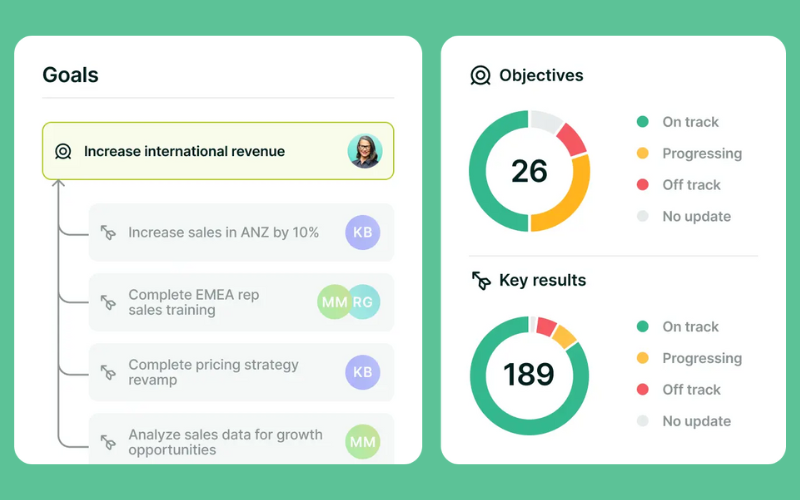
Lattice recently rolled out product updates focused on making feedback collection and goal tracking more efficient. The improvements are geared toward helping HR teams streamline workflows and while gathering clearer data from employees.
The update adds multi-select survey questions, so users can now choose more than one response in Engagement, Onboarding, and Exit Surveys. Goal tracking was also refined with better filters, clickable goal titles, and improved field validation during goal setup.
These updates reduce friction in daily tasks. Surveys become more informative, and managing goals takes less time and effort. For teams looking to boost productivity and clarity, these changes make a measurable difference.
Verdict: These are helpful workflow adjustments. However, I'm still waiting for them to release their performance improvement plans slated for Spring 2025!
Primalogik Update Notes
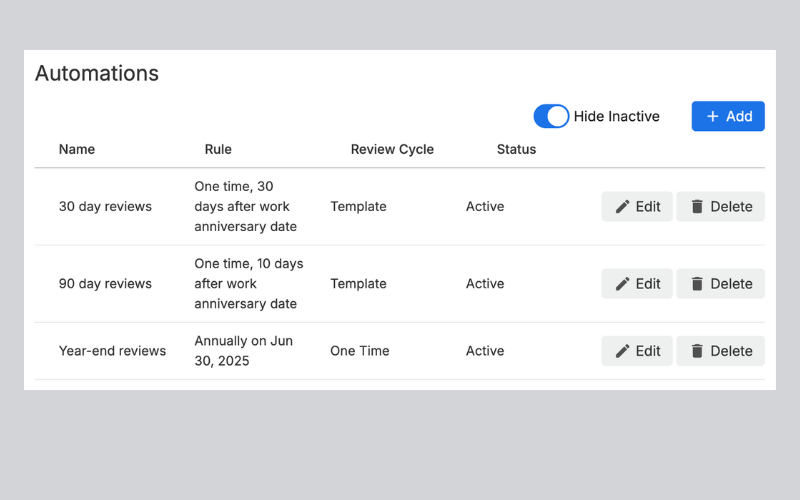
Primalogik recently introduced new automation rules for performance reviews. This update empowers HR teams to automate the scheduling and launch of appraisals using predefined criteria, helping organizations maintain a consistent and timely feedback cycle for their employees.
With Automation Rules, users can set up recurring annual reviews that automatically kick off on specific calendar dates, trigger appraisals based on hire dates to coincide with work anniversaries, and initiate 30-, 60-, or 90-day check-ins for new hires.
These rules can be combined and customized to fit any organization’s unique performance review cadence, removing the need for manual setup and oversight each cycle.
This update adds value by reducing administrative tasks, minimizing the chance of missed or delayed evaluations, and creating a seamless and scalable review process. By automating performance reviews, organizations can foster a more consistent feedback culture, ensure fair employee evaluations, and free up time for managers to focus on meaningful performance conversations.
Verdict: This update both reduces administrative tasks and fosters a more consistent feedback culture across teams, improving fairness and efficiency.
2025 Q1: Performance Software Updates
Peoplebox Update Notes
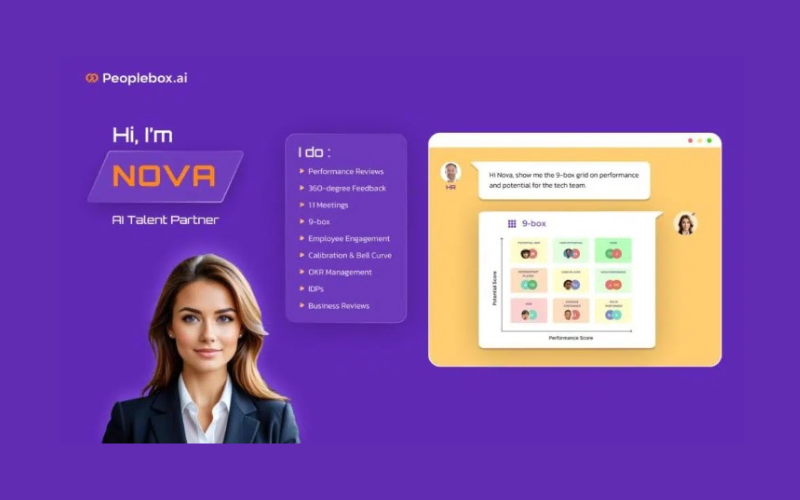
Peoplebox.ai has introduced two AI-powered assistants, Tara and Nova, to revolutionize talent acquisition and management. These AI employees are designed to alleviate the administrative burdens faced by HR teams.
Tara streamlines the recruitment process by swiftly screening resumes, sourcing candidates across various platforms, and maintaining a robust talent pipeline. Nova enhances talent management by automating performance review cycles, identifying skill gaps, and crafting actionable development plans for team members. Together, they aim to transform HR operations by handling repetitive tasks efficiently.
By integrating Tara and Nova into their workflows, organizations can expect improved efficiency in HR processes. This allows talent teams to dedicate more time to building meaningful relationships, fostering employee engagement, and cultivating a positive workplace culture, ultimately leading to better business outcomes.
Verdict: Hot! Peoplebox's new AI agents will help internal talent and recruitment teams eliminate manual work from their processes, speeding up tasks.
Performance Management Frequently Asked Questions
Here are some answers to frequently asked questions related to performance management processes and appraisal software.
Why is performance management important?
Regular performance-based feedback can improve your employee’s engagement and reduce your employee turnover rate. Recent research has shown that organizations that provide regular employee feedback have a 14.9% lower turnover rate than organizations that don’t provide regular feedback. Yet, 65% of employees want more feedback than they’re already receiving.
Similarly, employees who receive regular feedback are motivated to work harder, whereas those who don’t are actively disengaged from their work. Consider these stats from the same study:
- 69% of employees admit they would work harder if their efforts were recognized through feedback.
- 98% of employees disengage from their roles when receiving little or no feedback!
With that in mind, it certainly makes a strong case for prioritizing continuous performance management within your organization. Unless, of course, you want an unengaged and underperforming workforce!
What is a performance appraisal?
An employee performance appraisal is a type of performance management process that assesses the productivity and effectiveness of an employee that serves both administrative and development purposes. This type of performance appraisal process allows you to provide feedback and identify areas for improvement.
A popular style of performance appraisal is the behaviorally anchored rating scale or BARS. Interested in learning more about the BARS method, take a read of our article on measuring worker performance.
How often should performance reviews or appraisals be conducted?
Annual reviews are traditional, but more companies are moving towards quarterly or even monthly check-ins to keep goals aligned and address issues promptly. Additionally, a blend of formal and informal evaluations helps alleviate the pressure that can come with an infrequent and formal review process. Managers can check in on goals and performance indicators at regular one-on-one meetings with employees, and have more structured feedback discussions at dedicated, regular moments.
More frequent feedback helps maintain a continuous dialogue between managers and employees, fostering a culture of growth and agility. It makes it less likely that a formal review will come with surprises, and gives employees more opportunities to improve their performance in real-time. It’s all about finding the right balance that suits your organization’s culture and objectives.
How do performance management solutions work?
Performance management software helps managers by adding structure to the traditional performance review process. They automate the process of tracking key performance indicators (KPIs) or other specific metrics according to each team member’s job description. When set up effectively, these powerful HR tools track these items automatically and compile the final results into performance reports on a quarterly, semi-annual, or annual basis.
Performance reviews are an essential component of talent management, and the software is a modern solution for running performance review cycles successfully. They can also handle basic functions like scheduling, tracking, and data analysis, and incorporate modern elements like 360-degree feedback and continuous feedback loops.
What are performance management techniques?
There are many performance management tools and employee evaluation systems to ensure steady success within your organization. Such techniques include: setting SMART goals and objectives, leveraging digital performance appraisal tools, providing coaching, objective management, personal development plans, and reward and recognition programs.
How can performance management practices influence company culture?
Effective performance management practices foster a culture of continuous improvement, transparency, and accountability. When employees understand how their work contributes to larger goals, they’re more engaged and motivated. A culture that values regular feedback, recognizes achievements, and provides opportunities for professional development encourages employees to strive for excellence.
On the other hand, ineffective performance management practices can lead to employee disengagement and discontentment. Ideally practices will have structure without being too rigid and frequent enough to provide tangible, applicable feedback. The process should be reflective of company values and give space for both managers and employees to reflect on opportunities for improvement and celebrate accomplishments.
How have performance management tools adapted for remote and hybrid teams?
Since performance management tools are cloud-based (i.e., accessible over the internet) they can be used the same way by in-office, remote, and hybrid teams. This is one reason why it’s better to use performance management software instead of an old paper-based process. Here are some other aspects of performance management tools that also accommodate the needs of hybrid and remote teams:
- Integrated communication tools (i.e., Slack, Microsoft Teams, Yammer, Zoom) allow you to collect employee feedback from anywhere
- Feedback collection automations make it easy to collect feedback for project-based reviews from remote workers who haven’t worked face-to-face, but still worked on the same team or towards a common goal
- Integrated goal tracking that visualizes employee progress towards goals and improves transparency within teams
- One-on-one check-in tools make it easy to schedule meetings that accommodate different schedules and time zones
- Self-service portals enable your employees to access their performance records from anywhere
- Mobile accessibility further improves your employee’s access to information, including from mobile devices
How can managers address underperformance effectively?
Addressing employee underperformance can be tricky, and many managers might feel nervous and under-equipped to handle it effectively. It starts with clear, empathetic communication. Managers should meet with the employee to discuss specific concerns, using concrete examples.
It’s also crucial to listen to the employee’s perspective, as there might be underlying issues affecting their performance. Setting achievable, time-bound improvement goals together and offering the necessary support, like training or resources, is key. Regular check-ins to review progress and adjust the plan as needed can help. It’s about creating a supportive environment that encourages growth and improvement.
How can employee recognition tools help with performance management?
Employee recognition tools can boost performance management by reinforcing positive behaviors, increasing employee motivation, and improving engagement. They provide real-time feedback, highlighting top performers and encouraging others to follow suit. Recognition tools also help managers identify areas of strength and improvement, fostering a culture of continuous performance enhancement.
Thankfully, there are systems out there that combine performance management and employee recognition features. A great example of a combined people enablement platform is Lattice. Lattice helps managers monitor employee performance while providing real-time recognition, helping to drive engagement and continuous improvement simultaneously. Check out our in-depth review of Lattice if you’d like to learn more.
What is continuous feedback?
Continuous feedback is a component of modern performance management that gives managers and employees opportunities to give and receive feedback regularly. This can be accomplished in many ways, but often includes daily or weekly feedback cycles through check-ins or 1:1 meetings.
Most performance management software includes templates for providing this type of continuous feedback, with prompts automatically rolled out so nothing slips through the cracks. The feedback is also recorded in the system, making it easy to refer back to during a more formal annual performance review too.
Research has shown the clear benefits of continuous performance feedback. Organizations that use a continuous feedback model outperformed their competition by 24%. Similarly, companies who use continuous feedback models are 39% better at attracting top talent, and 44% better at retention.
What are the goals of performance management software?
The end goal of performance management software is to both help employees document their wins and successes and uncover any areas where they could potentially improve.
Many of these systems also integrate with other HR solutions for skill building, learning & development, and compensation. In addition, performance management software can also help organizations flag their top performers with the most potential for succession planning purposes.
Performance management software also helps to ignite employee productivity and ensure employees are aligned with their company's organizational goals. That's why it's common to find goal & OKR (objectives and key results) tracking features integrated within many performance management software solutions. Systems with these additional features help managers track team goals as well as individual goals, to ensure all parties are striving for the same end results.
How do these platforms handle data privacy and security?
Performance management software typically prioritizes data privacy and security by employing encryption, secure data storage, and compliance with international standards (e.g., GDPR, HIPAA). These measures ensure that employee data is protected from unauthorized access and breaches. Providers often highlight their security certifications and protocols, demonstrating their commitment to safeguarding sensitive information.
Other Performance Software Reviews
If you're looking for another type of performance-related software, look no further. To save you time, here are some links to my other performance-related reviews:
- Talent Management Software
- Employee Experience Software for Engagement & Performance
- Succession Planning Software to Develop Future Leaders
- Mentoring Software for Mentors and Mentees
- Employee Engagement Software
- Goal Setting Software for Keeping Teams on Track
- Productivity Tracking Software for Hybrid Teams
- OKR (Objectives and Key Results) Software
Final Thoughts
I hope this article got you one step closer to finding the right performance management tool for your organization.
These systems are an important tool in every HR team's operational tool belt since they automate large portions of the process, taking the stress of running a performance review cycle off your shoulders for good.
They'll also help your staff reach their full potential while documenting their career progress toward their individual career development goals.
Stay in Touch
Finding the right performance management software can transform the way you support, develop, and retain top talent.
Now that you’ve explored the top solutions, the next step is choosing the one that best fits your needs. Consider your company’s size, performance management goals, and must-have features as you narrow down your options. Many platforms offer free trials, so take advantage of them to see how the software fits into your workflow.
No matter which tool you choose, investing in performance management software is a step toward a more engaged, high-performing workforce.
I also recommend subscribing to our People Managing People newsletter. You'll get updates on our latest articles and podcasts from HR experts around the world.





